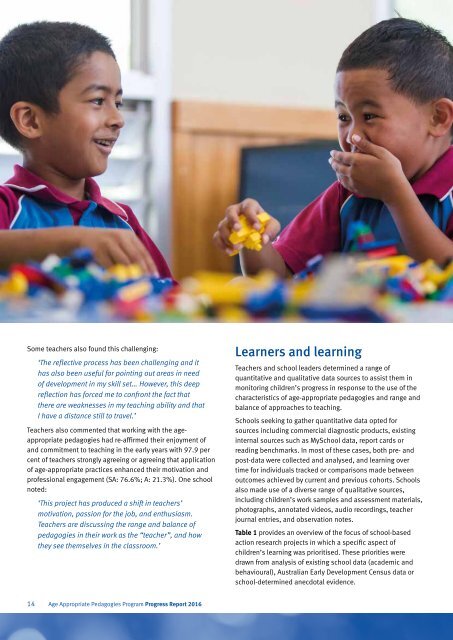Age Appropriate Pedagogies Program
aap-program-progress-report-2016
aap-program-progress-report-2016
You also want an ePaper? Increase the reach of your titles
YUMPU automatically turns print PDFs into web optimized ePapers that Google loves.
Some teachers also found this challenging:<br />
‘The reflective process has been challenging and it<br />
has also been useful for pointing out areas in need<br />
of development in my skill set… However, this deep<br />
reflection has forced me to confront the fact that<br />
there are weaknesses in my teaching ability and that<br />
I have a distance still to travel.’<br />
Teachers also commented that working with the ageappropriate<br />
pedagogies had re-affirmed their enjoyment of<br />
and commitment to teaching in the early years with 97.9 per<br />
cent of teachers strongly agreeing or agreeing that application<br />
of age-appropriate practices enhanced their motivation and<br />
professional engagement (SA: 76.6%; A: 21.3%). One school<br />
noted:<br />
‘This project has produced a shift in teachers’<br />
motivation, passion for the job, and enthusiasm.<br />
Teachers are discussing the range and balance of<br />
pedagogies in their work as the “teacher”, and how<br />
they see themselves in the classroom.’<br />
Learners and learning<br />
Teachers and school leaders determined a range of<br />
quantitative and qualitative data sources to assist them in<br />
monitoring children’s progress in response to the use of the<br />
characteristics of age-appropriate pedagogies and range and<br />
balance of approaches to teaching.<br />
Schools seeking to gather quantitative data opted for<br />
sources including commercial diagnostic products, existing<br />
internal sources such as MySchool data, report cards or<br />
reading benchmarks. In most of these cases, both pre- and<br />
post-data were collected and analysed, and learning over<br />
time for individuals tracked or comparisons made between<br />
outcomes achieved by current and previous cohorts. Schools<br />
also made use of a diverse range of qualitative sources,<br />
including children’s work samples and assessment materials,<br />
photographs, annotated videos, audio recordings, teacher<br />
journal entries, and observation notes.<br />
Table 1 provides an overview of the focus of school-based<br />
action research projects in which a specific aspect of<br />
children’s learning was prioritised. These priorities were<br />
drawn from analysis of existing school data (academic and<br />
behavioural), Australian Early Development Census data or<br />
school-determined anecdotal evidence.<br />
14 <strong>Age</strong> <strong>Appropriate</strong> <strong>Pedagogies</strong> <strong>Program</strong> Progress Report 2016


